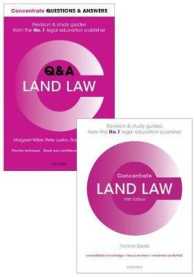Full Description
Regulating Offshore Petroleum Resources makes a unique comparison between the main regulatory characteristics of the Norwegian and British models for petroleum exploration, production and supply. Leading scholars explore the extent to which these models are relevant for the design of regulatory models in countries with significant existing petroleum resources. The applicability of these regulatory models to countries with potential petroleum resources is also assessed.
Providing a profound understanding behind the evolution of the British and Norwegian petroleum regimes, this innovative book investigates why these countries followed different paths and analyses the resultant outcomes. Key features include examination of the historical evolution of relevant petroleum regimes, lessons learnt, and an interdisciplinary approach from a range of recognised experts.
This comprehensive book will be of great value to regulation and environmental law scholars. Inspection of the ways in which these models can be applied to other countries will also be of interest to government officials and practitioners.
Contents
Contents:
Part I Introduction
1. Introduction
Eduardo G. Pereira and Henrik Bjørnbye
Part II Norway
2. Background - Norway
Erik Jarlsby
3. Hydrocarbon Policies and Legislation - Norway
Tonje Pareli Gormley and Merete Kristensen
4. Licensing Regime - Norway
Henrik Bjørnbye and Catherine Banet
Part III The United Kingdom
5. Background - The United Kingdom
Raphael Heffron, Mohammed Hazrati, Greg Gordon and Darren Mccauley
6. Hydrocarbon Policies and Legislation - The United Kingdom
Greg Gordon
7. Licensing Regime - The United Kingdom
Yanal Abul Failat
Part IV Conclusion
8. Conclusion
Eduardo G. Pereira and Henrik Bjørnbye
Index








